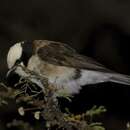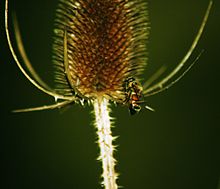en
names in breadcrumbs


Shrikes (/ʃraɪk/) are passerine birds of the family Laniidae. The family is composed of 34 species in four genera.
The family name, and that of the largest genus, Lanius, is derived from the Latin word for "butcher", and some shrikes are also known as butcherbirds because of their feeding habits.[1] The common English name shrike is from Old English scrīc, alluding to the shrike's shriek-like call.[2]
The family Laniidae was introduced (as the subfamily Lanidia) in 1815 by the French polymath Constantine Samuel Rafinesque. The type genus Lanius had been introduced by Carl Linnaeus in 1758.[3][4] As currently constituted the family contains 34 species in four genera. It includes the genus Eurocephalus with the two white-crowned shrikes.[5] A molecular phylogenetic study published in 2023 found that the white-crowned shrikes were more closely related to the crows in the family Corvidae than they are to the Lariidae and authors proposed that the genus Eurocephalus should be moved to its own family Eurocephalidae. The cladogram below is based on these results:[6]
PlatylophidaePlatylophus – crested jayshrike
LaniidaeLanius – shrikes and fiscals (30 species)
Urolestes – magpie shrike
Corvinella – yellow-billed shrike
(Eurocephalidae)Eurocephalus – white-crowned shrikes (2 species)
Corvidae24 genera (135 species)
Most shrike species have a Eurasian and African distribution, with just two breeding in North America (the loggerhead and northern shrikes). No members of this family occur in South America or Australia, although one species reaches New Guinea. The shrikes vary in the extent of their ranges, with some species, such as the great grey shrike, ranging across the Northern Hemisphere; to the Newton's fiscal, which is restricted to the island of São Tomé.[7]
They inhabit open habitats, especially steppe and savannah. A few species of shrikes are forest dwellers, seldom occurring in open habitats. Some species breed in northern latitudes during the summer, then migrate to warmer climes for the winter.
Shrikes are medium-sized birds with grey, brown, or black-and-white plumage. Most species are between 16 cm (6.3 in) and 25 cm (9.8 in) in size; however, the genus Corvinella, with its extremely elongated tail-feathers, may reach up to 50 cm (20 in) in length. Their beaks are hooked, like those of a bird of prey, reflecting their carnivorous nature; their calls are strident.

Male shrikes are known for their habit of catching insects and small vertebrates and impaling them on thorns, branches, the spikes on barbed-wire fences, or any available sharp point. These stores serves as a cache so that the shrike can return to the uneaten portions at a later time.[8] The primary function of conspicuously impaling prey on thorny vegetation is however thought to be for males to display their fitness and the quality of the territory held to prospective mates.[9] The impaling behavior increased during the onset of the breeding season.[10] Female shrikes have been known to impale prey, but primarily to assist in dismembering prey.[11] This behaviour may also serve secondarily as an adaptation to eating the toxic lubber grasshopper, Romalea microptera. The bird waits 1–2 days for the toxins within the grasshopper to degrade before eating it.[12]
Loggerhead shrikes kill vertebrates by using their beaks to grab or pierce the neck and violently shake their prey.[13]
Shrikes are territorial, and these territories are defended from other pairs. In migratory species, a breeding territory is defended in the breeding grounds and a smaller feeding territory is established during migration and in the wintering grounds.[7] Where several species of shrikes exist together, competition for territories can be intense.
Shrikes make regular use of exposed perch sites, where they adopt a conspicuous upright stance. These sites are used to watch for prey and to advertise their presence to rivals.
Shrikes are generally monogamous breeders, although polygyny has been recorded in some species.[7] Co-operative breeding, where younger birds help their parents raise the next generation of young, has been recorded in both species in the genera Eurocephalus and Corvinella, as well as one species of Lanius. Males attract females to their territory with well-stocked caches, which may include inedible but brightly coloured items. During courtship, the male performs a ritualised dance which includes actions that mimic the skewering of prey on thorns, and feeds the female. Shrikes make simple, cup-shaped nests from twigs and grasses, in bushes and the lower branches of trees.[8]
FAMILY: LANIIDAE[5]
Other species with names including the word shrike, due to perceived similarities in morphology, are in the following families:
The helmetshrikes and bushshrikes were formerly included in Laniidae, but they are now known to be not particularly closely related to true shrikes.
The Australasian butcherbirds are not shrikes, although they occupy a similar ecological niche.
Shrikes (/ʃraɪk/) are passerine birds of the family Laniidae. The family is composed of 34 species in four genera.
The family name, and that of the largest genus, Lanius, is derived from the Latin word for "butcher", and some shrikes are also known as butcherbirds because of their feeding habits. The common English name shrike is from Old English scrīc, alluding to the shrike's shriek-like call.